Safety and Security
The Infiniti JX’s extensive list of standard safety features includes an Advanced Air Bag System (AABS) with dual-stage supplemental front air bags that include seat belt and occupant classification sensors. The JX is equipped with roof-mounted curtain side impact supplemental air bags with rollover sensor for outboard occupant head protection for all three rows. It also comes with front seat-mounted side impact supplemental air bags; 3-point front seat belts with pretensioners, load limiters and seat belt reminder. The JX is equipped with 3-point adjustable seat belts for front and rear seats. All seat belt retractors are Emergency Locking Retractors (ELR) type. In an emergency (sudden stop) the retractor will lock and prevent the webbing from extending any further. All 3-point type seat belt retractors except the driver seat belt also have an Automatic Locking Retractors (ALR) mode. Other safety features are the LATCH System (Lower Anchors and Tethers for CHildren) and child-safety rear door locks. The second-row center seat is equipped with a child seat top tether as well as the third-row passenger side seat. The JX also has Zone Body construction with front- and rear-crumple zones and steel side-door guard beams.
Infiniti Advanced Air Bag System
The JX is equipped with the Infiniti Advanced Air Bag System for the driver and front passenger seats. The driver supplemental front-impact air bag is located in the center of the steering wheel, and the passenger supplemental front-impact air bag is mounted in the dashboard above the glove box. The front air bags are designed to inflate in higher-severity frontal collisions, although they may inflate if the forces in another type of collision are similar to those of a higher-severity frontal impact. Vehicle damage (or lack of it) is not always an indication of proper front air bag system operation.
The Infiniti Advanced Air Bag System has dual-stage inflators. The system monitors information from the crash zone sensor, the Air bag Control Unit (ACU), seat belt buckle sensors and Occupant Classification Sensor (weight sensor). Inflator operation is based on the severity of a collision and seat belt usage for the driver. For the front passenger, it additionally monitors the weight of an occupant or object on the seat. Based on information from the sensors, only one front air bag may inflate in a crash. This depends on the crash severity and whether the front occupants are belted or unbelted. One front air bag inflating does not indicate improper performance of the system. The front passenger air bag may be automatically turned OFF under some conditions, depending on the weight detected on the passenger seat, and how the seat belt is used. If the front passenger air bag is OFF, the passenger air bag status light will be illuminated (if the seat is unoccupied, the light will not be illuminated, but the air bag will be OFF).
CONSULT Function
The JX vehicle adopts occupant classification system with a weight-detecting method. When replacing, or removing and installing the passenger seat, always perform the “zero point reset” so that the vehicle recognizes zero point.
![]()
If zero point reset is incomplete, the occupant detection sensor does not operate normally.
Zero point reset is an initializing procedure for the OCS (weight) sensors that must be performed using CONSULT when removing and installing passenger seat or servicing the OCS system.
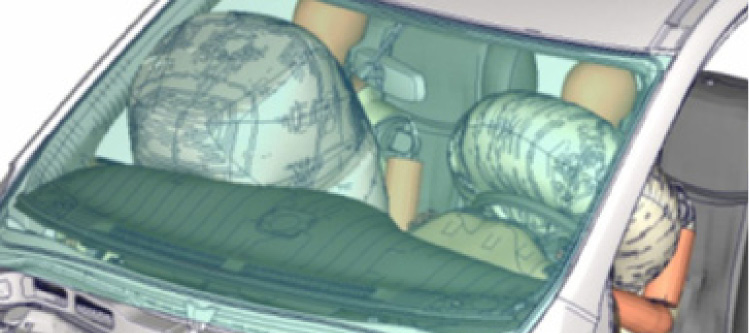
SLIDE DOUBLE LOCKING CONNECTORS
A new style slide double-locking type connector is used on certain systems and components, especially those related to airbag control systems. The slide double-locking type connectors are disconnected by pushing or pulling the slider.
Tire Pressure Monitoring System (TPMS)
This system monitors tire pressure in real time to let a customer know when tire pressure decreases 25% below the recommended pressure. The TPMS Warning Light will illuminate.
With four-corner real time display, the tire pressure of “each tire” is indicated on the information display meter.
Using the existing Intelligent Key system’s antennas, the vehicle triangulates the position of each tire via radio waves of three antennas and adjusts the TPMS display on the Information screen accordingly. When ON, this design is a smart yet simple solution that requires no intervention from the customer to access up-to-date information.
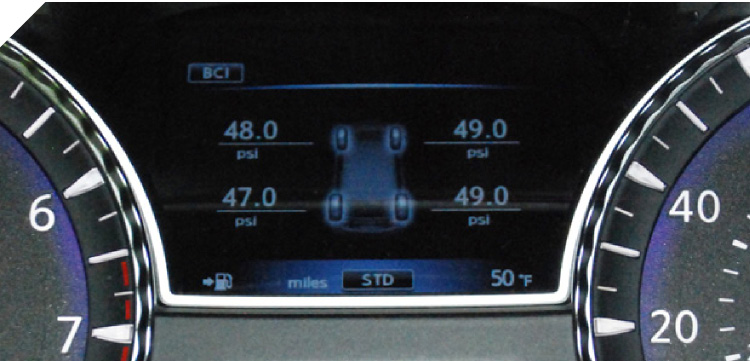
TPMS System Description
When the vehicle has reached a speed of 40 km/h (25 MPH) or greater, the BCM receives a signal transmitted from the tire pressure sensors/transmitters installed in each wheel. If the BCM detects low inflation pressure or a system malfunction, it sends a signal to the combination meter via CAN communication to illuminate the low tire pressure warning lamp. In addition, a warning message will be displayed in the vehicle information display.
Easy Fill Tire Alert Function
The new JX utilizes a Tire Pressure Monitoring System with Easy Fill Tire Alert. With Easy Fill Tire Alert, the TPMS sensors on the new JX can send a signal through the TPMS that flashes the hazard indicators and sounds the horn when you’re filling the tires and the pressure reaches the recommended tire pressure. If the tire is over-inflated by more than 4 psi while you’re filling the tires, the horn beeps and the hazard indicators flash 3 times. To correct the pressure, push the core of the valve stem on the tire briefly to release pressure. When the pressure reaches the recommended cold tire pressure, the horn beeps once. This function operates only when the shift lever position is in Park (P) with the ignition ON.
NOTE: When beginning tire inflation, it takes a few seconds for the Easy-Fill tire alert to function. If there is no response for approximately 15 seconds or more, cancel the easy-fill tire alert function and move the vehicle approximately 1 m (3.2 ft) backward or forward, and then try again.
- The Easy-Fill tire alert function operates only when the shift lever position is in P-range (Park) with the ignition switch ON.
- This function informs the driver with a visual and audible indication that the recommended COLD tire pressure has been reached.
- The hazard warning lamps blink when the recommended COLD tire pressure has been reached. After the recommended COLD tire pressure has been reached, the horn sounds once and the hazard warning lamps stop blinking.
- If the tire pressure value is equal to or greater than 30 kPa (0.31 kg/cm2, 4 psi) more than the recommended COLD tire pressure, the hazard warning lamps flash and the horn sounds three times.
To return the tire to the recommended COLD tire pressure, deflate the tire until the horn sounds once and the hazard warning lamps stop blinking.
VEHICLE SECURITY SYSTEM
The vehicle security system provides visual and audible alarm signals if someone opens the doors, liftgate or hood when the system is armed. It is not a motion-detection type system.
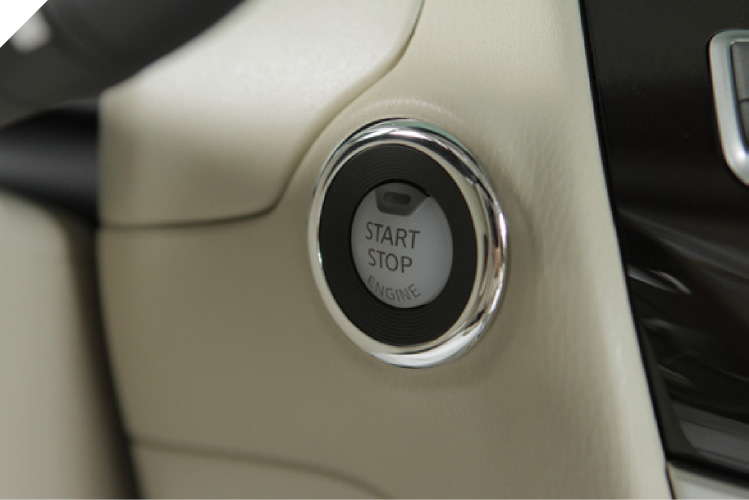
Infiniti Vehicle Immobilizer System
The Infiniti Vehicle Immobilizer System will not allow the engine to start without the use of a registered Infiniti Vehicle Immobilizer System key.
If the engine fails to start using a registered Infiniti Vehicle Immobilizer System key (for example), when interference is caused by another Infiniti Vehicle Immobilizer System key, an automated toll road device or automatic payment device on the key ring), start the engine using the following procedures:
1. Leave the ignition switch in the ON position for approximately five seconds.
2. Place the ignition switch in the OFF or LOCK position, and wait approximately 10 seconds.
3. Repeat steps 1 and 2.
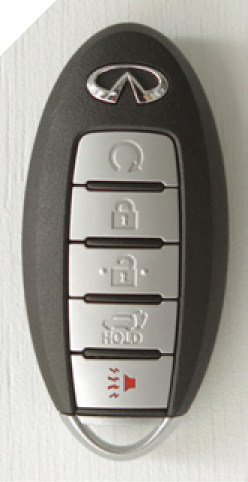
NOTE: If the no-start condition recurs, suggest to customers that they place the registered Infiniti Vehicle Immobilizer System key on a separate key ring to avoid interference from other devices.
Around View® Monitor With Moving Object Detection
The Around View® Monitor (AVM) system was designed to help enhance visibility when parking. AVM creates and displays views of every side of the vehicle, which helps reduce blind spots when parking.
The system consists of four ultra-wide-angle cameras:
- One in the rear license plate finisher
- One behind the Infiniti badge in the front grille
- One under each outside mirror
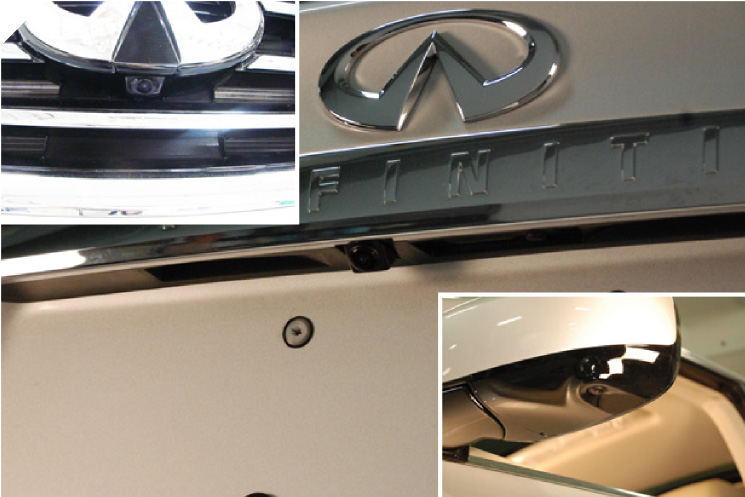
How it Works
A computer synthesizes the images taken by the four cameras to display a virtual overhead view of the vehicle and any objects that are low and close by the vehicle. The system can be activated when the vehicle is stopped by pushing the CAMERA button on the center console or shifting into Reverse. When activated, the LCD screen in the center dash displays two views. The right side of the display shows the synthesized overhead view of the vehicle, revealing the position of the vehicle in relation to parking lot lines, the curb, parked cars, or other obstacles. The left view shows the view directly behind the vehicle (when the transmission is in Reverse) or in front of the vehicle (when the transmission is in Drive at low speeds).
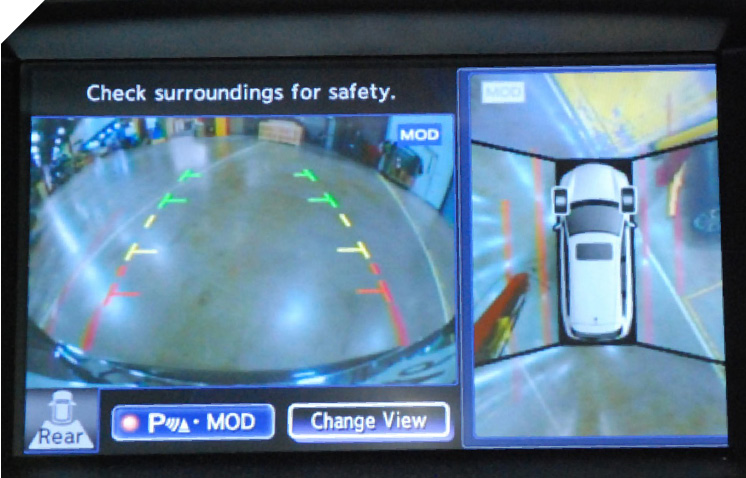
In the front and rear views, green, yellow, and red lines are displayed to help judge distances. Separate orange lines are coordinated with steering wheel movement. They bend to indicate the direction the vehicle is moving.
With the transmission in Reverse, two views appear on the center display screen. On the left is the camera view to the rear of the vehicle with guide markings that show the path the vehicle will follow. On the right is a composite view from above, showing the position of the vehicle. As you back into the spot, the guide markings bend to show the way the vehicle is being steered. The overhead view helps make it easier to judge your position. It shows how close you are to the curb, parked cars, or other obstacles.
When you press the CAMERA button, the overhead view is replaced with a view of the right side of the vehicle. This is especially helpful when parallel parking. When you put the transmission in Drive to pull forward and center the vehicle, the left side of the display shows the view to the front of the vehicle.
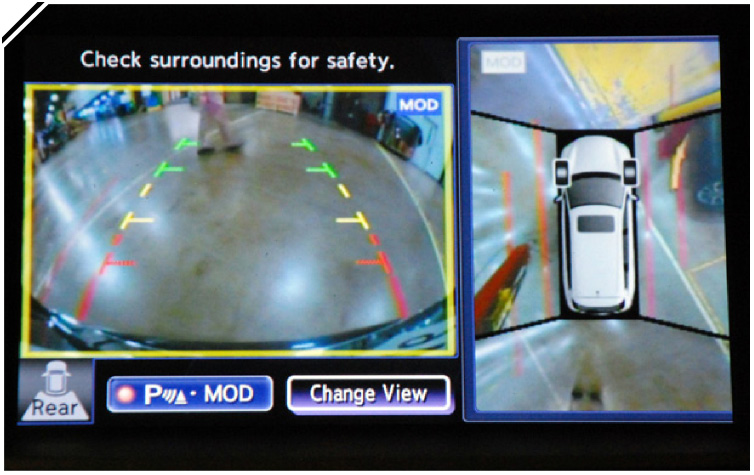
Moving Object Detection (MOD)
This Moving Object Detection system works in combination with the Around View Monitor (AVM) system, which shows the driver a video image of the area surrounding the vehicle. The new function helps the driver avoid a collision by providing visual and audible warnings. The system detects moving objects within the displayed image area in situations such as pulling out of a parking space.
The system functions by using sophisticated image-processing technology, applied to images from the four cameras used by the Around View Monitor System. When the vehicle is placed in reverse, the rear camera’s image-processing function works to detect moving object, such as pedestrians, around the vehicle. On detection of a moving object, the MOD function will provide the driver visual and audible warnings. Before driving, the system detects moving objects and displays them with the “top view” and Indicates the view with a yellow box. When the vehicle is in Reverse (R) the system detects moving objects crossing within the “front view” or “rear view.”
BACK-UP COLLISION INTERVENTION SYSTEM
The Infiniti JX is available with a new driver assistance feature called Back-up Collision Intervention (BCI). This technology will not only help a driver detect moving objects crossing behind their vehicle, but will also if necessary, automatically engage the brakes to help avoid a collision. When in reverse with the system turned ON, the BCI system continually monitors the area at the rear of the car in order to help avoid backup collisions. The Back-up Collision Intervention feature is mainly intended for use while pulling out of spots in parking lots. Whenever an approaching vehicle is detected, the system will make sure the driver is alerted with beeps and a blinking warning light. If the driver continues backing the system will generate braking force for two to three seconds, thanks to ESC (Electronic Stability Control), to alert the driver to apply the brake and stop moving further.
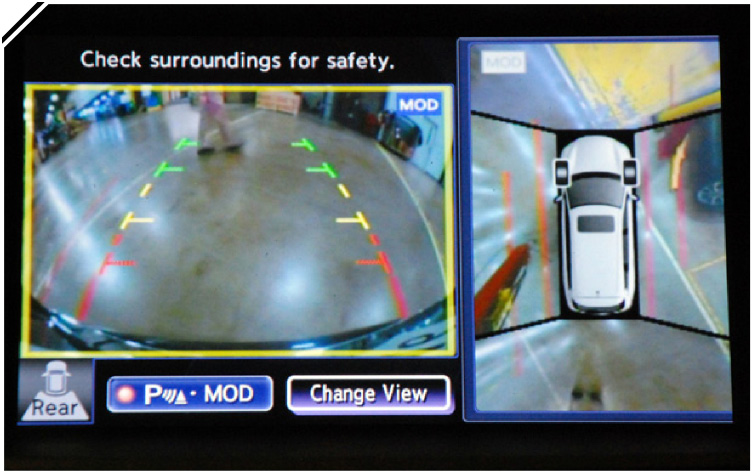
BCI System Operation
When the vehicle is in Reverse (R), the Back-up Collision Intervention system is operational. It combines high-frequency sonar with the Blind Spot Intervention system’s 24GHz radars installed on the left and right sides of the rear bumper. The system detects obstacles to the rear of the car as well as vehicles and objects encroaching on either side of it. This is intended to help to alert the driver to their presence. BCI combines high frequency sonar with the Blind Spot Intervention system’s millimeter radar beacons on the left and right sides of the rear bumper. The system also uses the four sonar sensors mounted in the rear bumper to detect obstacles.
If the system detects an approaching vehicle, the system chimes a sound (single beep), flashes the BCI indicator light on the same side as the approaching vehicle and displays the yellow frame on the birds-eye view. The radar sensor detects the approaching vehicles approximately 15 yards (15 m) away. The sonar sensor can detect obstacles approximately 5 feet (1.5 m) away. The BCI system is operational when the vehicle is in Reverse and the vehicle moving less than 5 mph (8 km/h). If the BCI system detects an object and the driver’s foot is on the accelerator pedal, the system moves the accelerator pedal upward, and also applies the brakes for two seconds, to alert the driver.
![]()
The BCI system may not provide warning or brake for a fast-approaching vehicle, a small obstacle or an obstacle close to the bumper.
The BCI system is not a replacement for proper driving procedure and is not designed to prevent contact with vehicles or objects.
BCI Indicator
The Blind Spot Warning (BSW) indicator lights illuminate for a few seconds when the ignition switch is pushed to the ON position.
The brightness of the BSW indicator lights are adjusted automatically, depending on the brightness of the ambient light. (The driver can change brightness by a setting in the combination meter.)
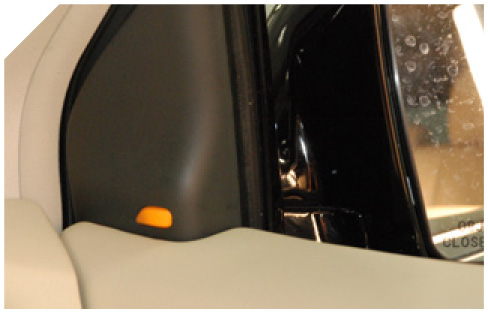
The BCI ON/OFF switch allows the driver to turn the BCI system ON and OFF. To turn the BCI system OFF, the engine must be started. If the selector is in R (Reverse) and the BCI system is OFF, the BCI system state is displayed on the meter display.
The system will automatically reset to ON, the next time the engine is started.
The automatic activation function can be turned ON or OFF with the Settings menu for Driver Assistance menu items in the Information display.
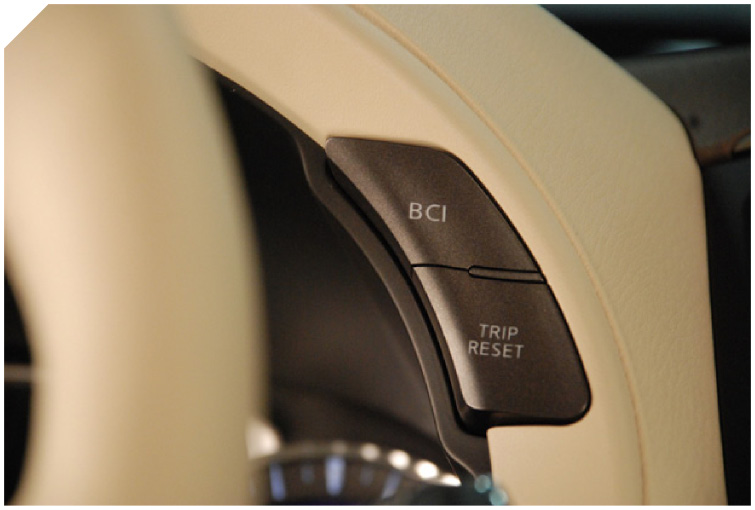
BCI Driving Situations
If the system detects an approaching vehicle, the system sounds a chime (single beep), flashes the BSW indicator in the direction of the detected vehicle and displays the yellow frame on the birds-eye view. If the approaching vehicle is too fast or slow, the system may not detect it. When backing out of parking space, always use the side and rear mirrors and turn and look in the direction you will move.
When the system detects an approaching vehicle continuously, the system flashes the BSW indicator light in the direction of the detected vehicle. However, the system will chime a sound again approximately three seconds after the system’s first warning.
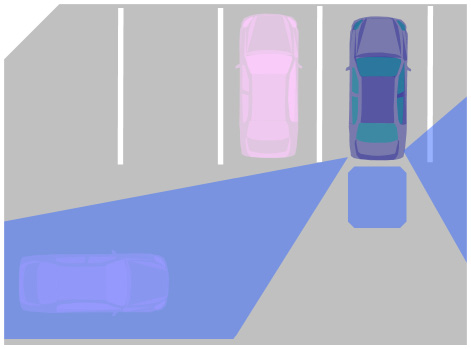
In the case of several vehicles approaching in a row, or in opposite direction, a chime may not be issued after the first vehicle passes the sensors. The sonar system sounds a tone, and the BCI system does not chime.
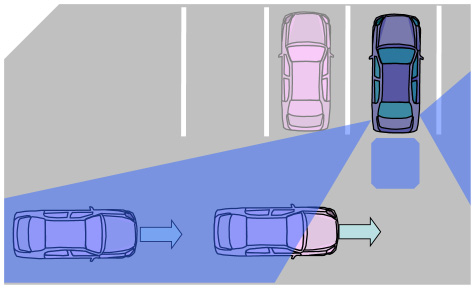
If the system detected the approaching vehicle or obstacle coming close when backing up, it issues an audible warning (three times), alerts the driver with a red frame on the display, and applies the brakes momentarily.
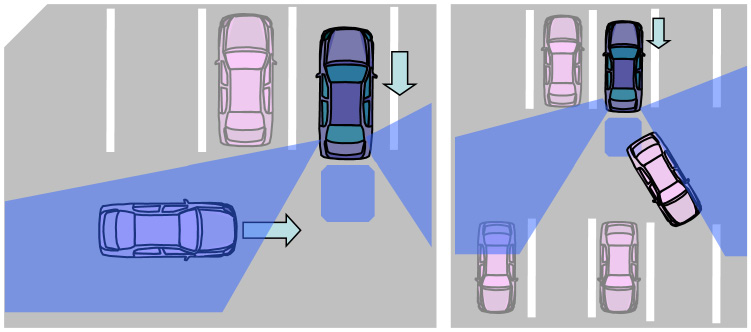
When parking in diagonal parking spaces, the range of the radar sensor decreases and the radar sensors may not be able to detect and activate the BCI system.
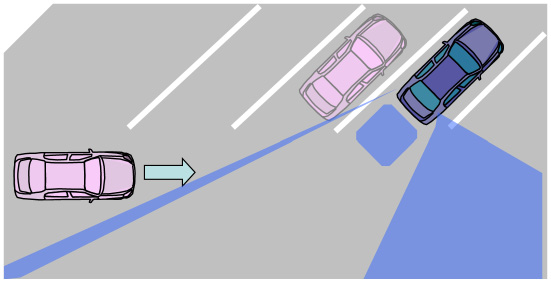
As you steer, the range of the radar sensor decreases and the radar sensors may not be able to detect and activate the BCI system.
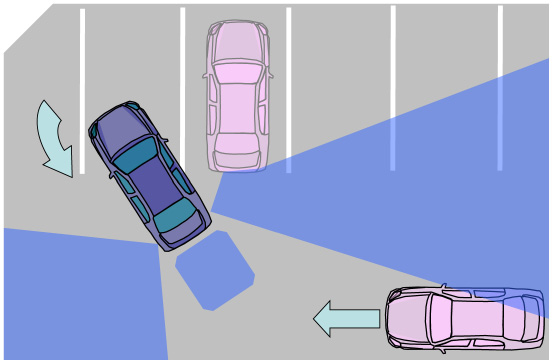
However, if the sonar sensors detected that the distance from the obstacle comes close during backing up, the system issues an audible warning (three times) and displays the red frame on the birds-eye around view and applies the brakes for a short period of time.
When backing into a parking space, the system may detect an adjacent vehicle or a structure.
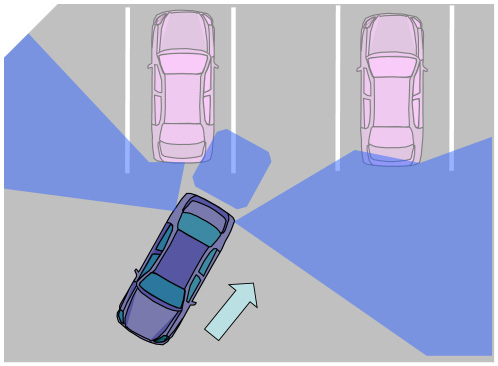
BCI temporarily not available
Under the following conditions, the BCI systems will be turned off automatically, a beep will sound and the BCI system yellow icon is displayed on the meter display.
The Blind Side Warning (BSW) and Blind Side Intervention (BSI) systems are not available until the following conditions no longer exist:
- When radar blockage is detected.
- When the accelerator pedal actuator detects that the internal motor temperature is high (over approximately 100 C).
The radar sensors may be blocked by temporary ambient conditions such as splashing water, mist or fog. The blocked condition may also be caused by objects such as ice, frost or dirt obstructing the radar sensors.
BCI malfunction
When the BCI system malfunctions, it will be turned off automatically, a beep will sound and the BCI system indication will display.
System Maintenance
The BCI system uses the same two radar sensor units that are used by the BSW/BSI system located near the rear bumper. For maintenance of the radar sensor, see “BSW SYSTEM/BSI SYSTEM” in the ESM.
The BCI system uses the same sonar sensor that is used by the SONAR system located near the rear bumper.
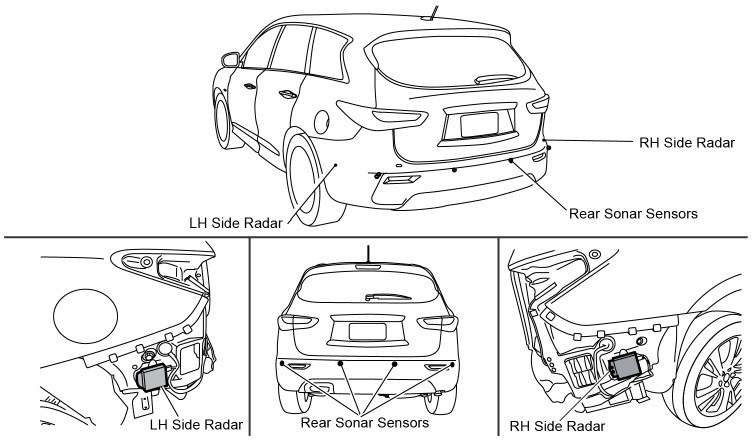
Brake Operated Pre-Crash Seat Belt and Intelligent Brake Assist System
The intelligent Brake Assist and brake operated Pre-crash seat belt systems work together to reduce the number of fatality accidents.
Brake Operated Pre-Crash Seat Belt System
A motorized seat belt retractor restrains the occupant in the following situations:
1. The system detects emergency braking by the speed and amount of the brake pedal operation.
2. Intelligent Brake Assist is activated.
The brake-operated pre-crash seat belt system helps minimize the occupant’s motion during sudden braking to enable the driver to control the vehicle in an emergency situation. If the crash is unavoidable, early seat belt restraint can help maximize the effectiveness of
the other occupant protection devices (such as air bags).
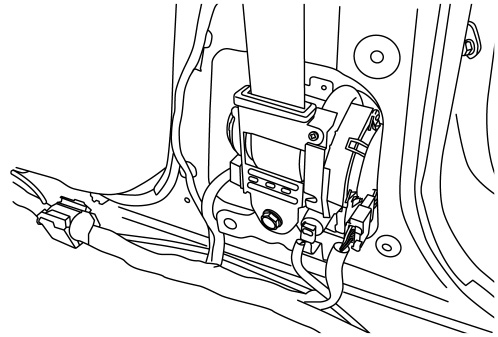
Intelligent Brake Assist
The intelligent Brake Assist system helps reduce occupant injuries in rear end collisions. Rear-end collision is the most frequent type of traffic accident. The IBA system functions when the vehicle is driven at approximately 10 MPH and above, and when the vehicle is driven 10 MPH faster than the vehicle ahead.
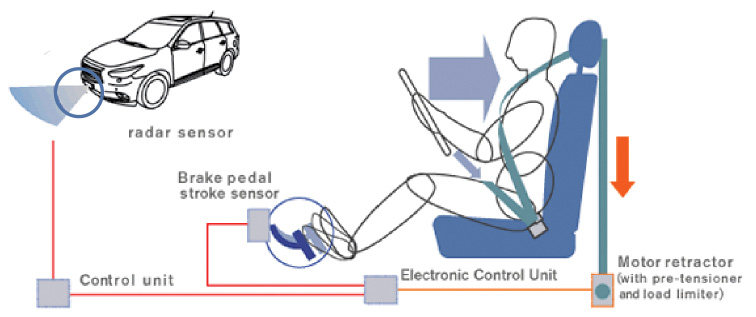
The laser radar sensor detects the distance to a preceding vehicle and the relative velocity. If necessary, the system activates the brakes of the vehicle.
The vehicle assists the driver’s braking action according to the situation. Intelligent Brake Assist helps reduce rear-end collision speed and it also works in concert with the Brake-Operated Pre-crash Seatbelts to help mitigate injuries in the event a collision is unavoidable.
When the system judges that your vehicle is getting close to a vehicle ahead in the traveling lane, the vehicle ahead detection indicator light on the instrument panel blinks and a warning chime sounds. This is the Forward Collision Warning (FCW).
When a rear-end collision cannot be avoided by the driver’s action, the system activates the brakes to decelerate the vehicle, thereby helping to reduce rearend collision speed.
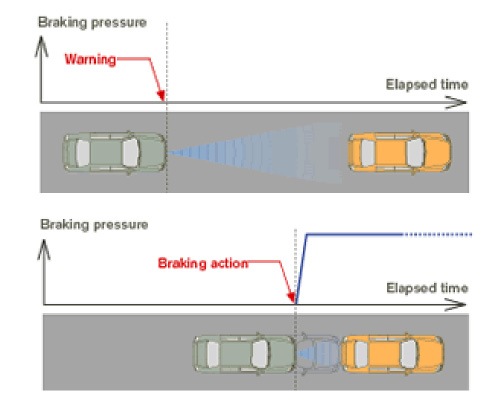
Brake Assist (with a preview function)
When the system judges emergency braking is needed, based on the distance to the followed vehicle and relative velocity, the system reduces play in the braking system to improve braking response.
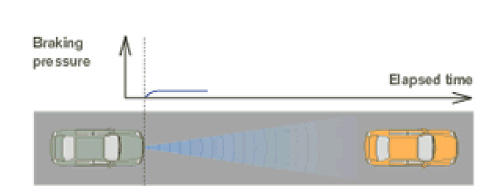
NOTE: When the Ignition switch is ON, the IBA system can be turned ON/OFF by the settings menu in the Driver Assistance items of the Vehicle Information Display.
Lane Departure Prevention (LDP) and Lane Departure Warning (LDW)
The Lane Departure Prevention (LDP) system assists the driver to avoid unintended lane departure.
The Lane Departure Warning (LDW) system helps support the driver in keeping the vehicle in its lane of travel. The driver is alerted by a display indicator and an audible warning when the vehicle unintentionally drifts out of its travel lane.
A camera unit installed behind the windshield detects lane markers in front of the vehicle and calculates its position relative to the lane markers. The brake actuator controls the brake pressure of each wheel individually to generate intended movement.

NOTE: The LDW/LDP system will operate when the vehicle is driven at approximately 45 MPH and above and when the vehicle is traveling too close to the left or right of a traveling lane.
When the vehicle is getting close to lane markers as a result of driver inattention, the LDW system warns the driver to pay attention to driving by display and audible buzzer and assists the driver to return the vehicle in the direction of center of the travel lane by generating part of the necessary yaw moment.
The LDP and LDW systems start with a quick warning in case of unintended lane departure. Then it starts a gentle control to firmly assist the driver’s maneuver, and finally the brake actuator is used to turn the vehicle back into the center of the lane.
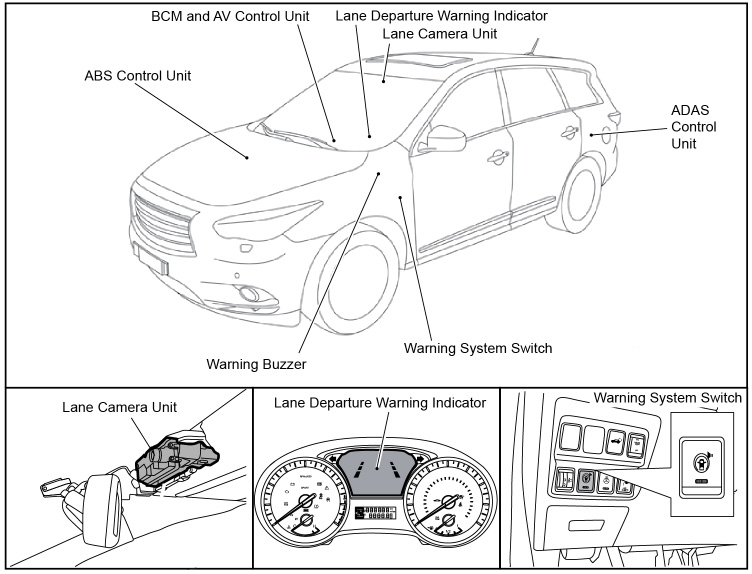
NOTE: If the Warning System’s switch has been pushed from OFF to ON continuously for 4 seconds, this will change the default status of the LDW, BSW, and FCW systems to OFF.

Customers can activate or deactivate individual systems using the Driving Aids Settings menu.
Follow these steps:
- Press the SETTING button.
- Select Driver Assistance.
- Select Dynamic Assistance Settings.
- Select the system you wish to activate or deactivate.